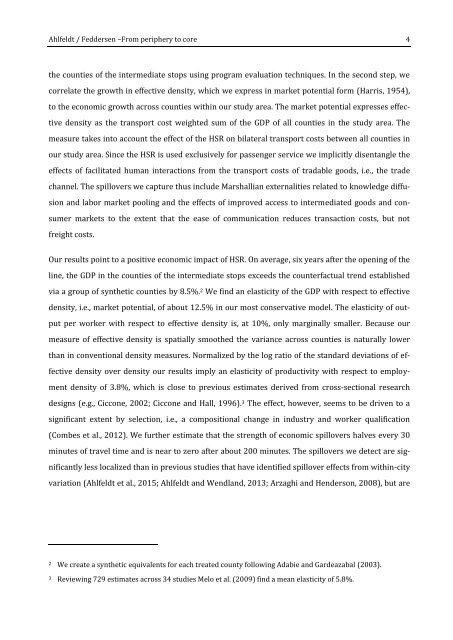sercdp0172
sercdp0172
sercdp0172
You also want an ePaper? Increase the reach of your titles
YUMPU automatically turns print PDFs into web optimized ePapers that Google loves.
Ahlfeldt / Feddersen –From periphery to core 4the counties of the intermediate stops using program evaluation techniques. In the second step, wecorrelate the growth in effective density, which we express in market potential form (Harris, 1954),to the economic growth across counties within our study area. The market potential expresses effectivedensity as the transport cost weighted sum of the GDP of all counties in the study area. Themeasure takes into account the effect of the HSR on bilateral transport costs between all counties inour study area. Since the HSR is used exclusively for passenger service we implicitly disentangle theeffects of facilitated human interactions from the transport costs of tradable goods, i.e., the tradechannel. The spillovers we capture thus include Marshallian externalities related to knowledge diffusionand labor market pooling and the effects of improved access to intermediated goods and consumermarkets to the extent that the ease of communication reduces transaction costs, but notfreight costs.Our results point to a positive economic impact of HSR. On average, six years after the opening of theline, the GDP in the counties of the intermediate stops exceeds the counterfactual trend establishedvia a group of synthetic counties by 8.5%. 2 We find an elasticity of the GDP with respect to effectivedensity, i.e., market potential, of about 12.5% in our most conservative model. The elasticity of outputper worker with respect to effective density is, at 10%, only marginally smaller. Because ourmeasure of effective density is spatially smoothed the variance across counties is naturally lowerthan in conventional density measures. Normalized by the log ratio of the standard deviations of effectivedensity over density our results imply an elasticity of productivity with respect to employmentdensity of 3.8%, which is close to previous estimates derived from cross-sectional researchdesigns (e.g., Ciccone, 2002; Ciccone and Hall, 1996). 3 The effect, however, seems to be driven to asignificant extent by selection, i.e., a compositional change in industry and worker qualification(Combes et al., 2012). We further estimate that the strength of economic spillovers halves every 30minutes of travel time and is near to zero after about 200 minutes. The spillovers we detect are significantlyless localized than in previous studies that have identified spillover effects from within-cityvariation (Ahlfeldt et al., 2015; Ahlfeldt and Wendland, 2013; Arzaghi and Henderson, 2008), but are2 We create a synthetic equivalents for each treated county following Adabie and Gardeazabal (2003).3 Reviewing 729 estimates across 34 studies Melo et al. (2009) find a mean elasticity of 5.8%.


